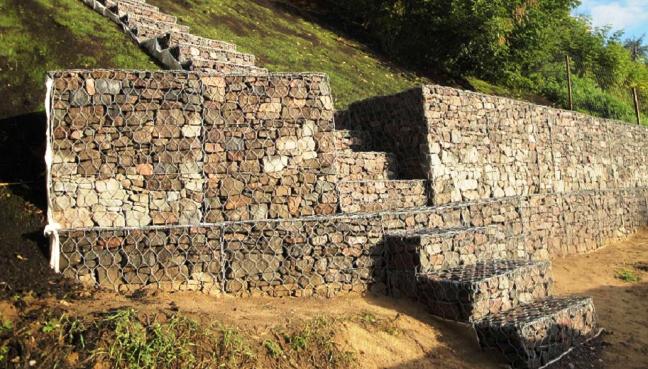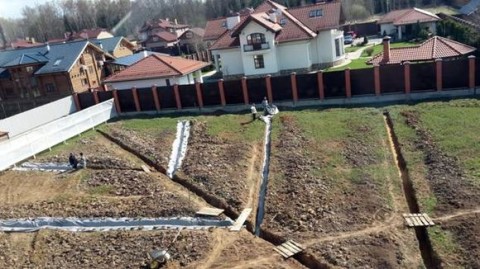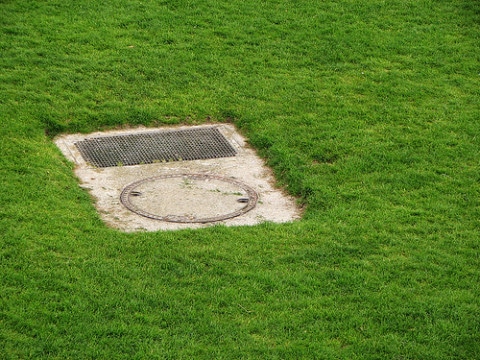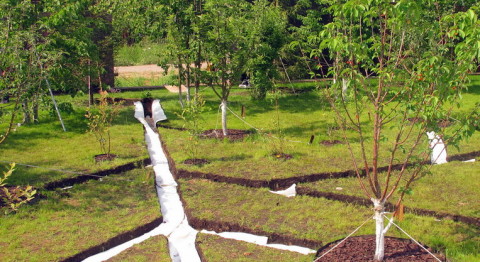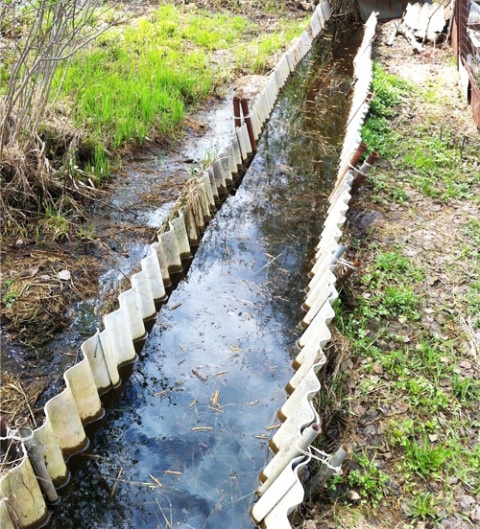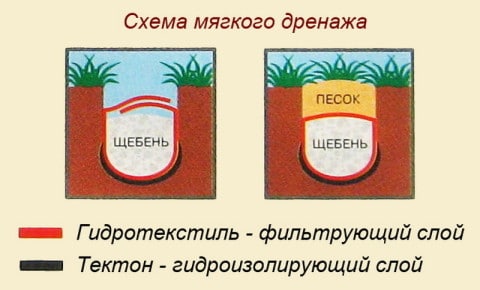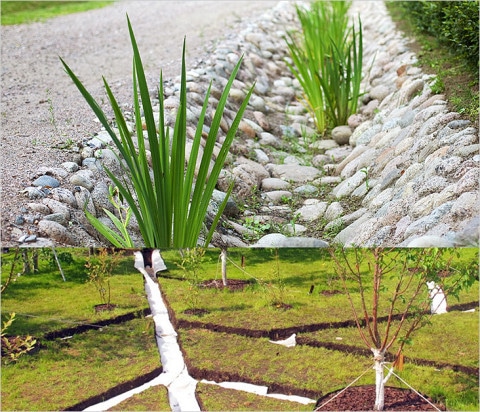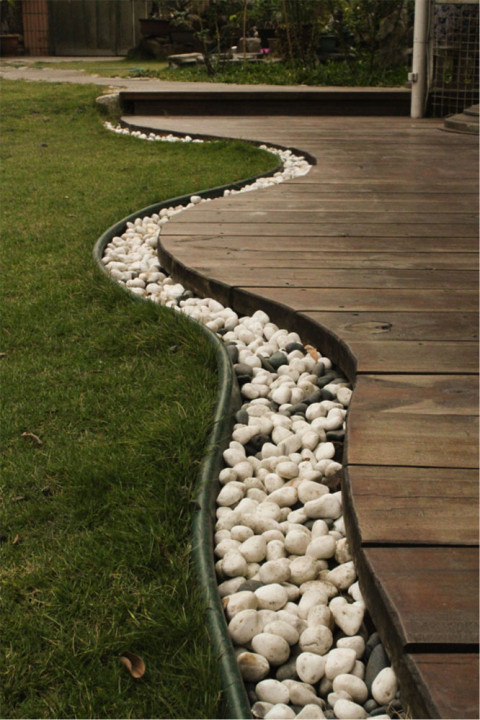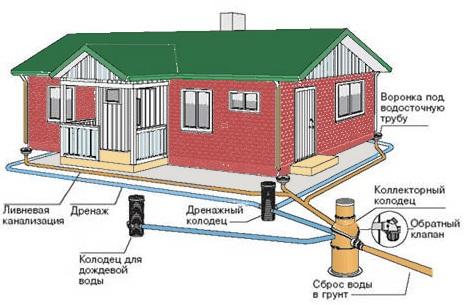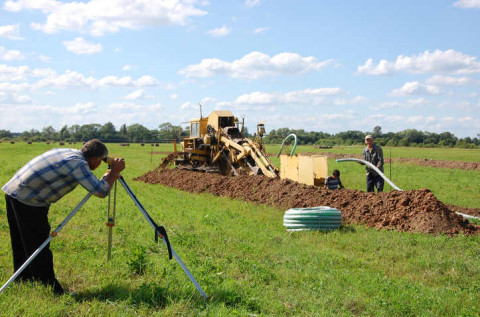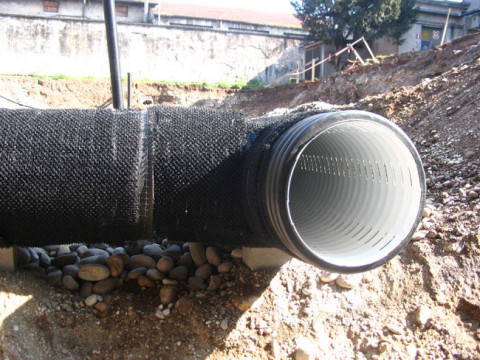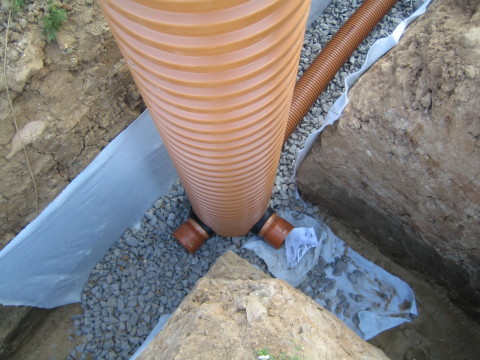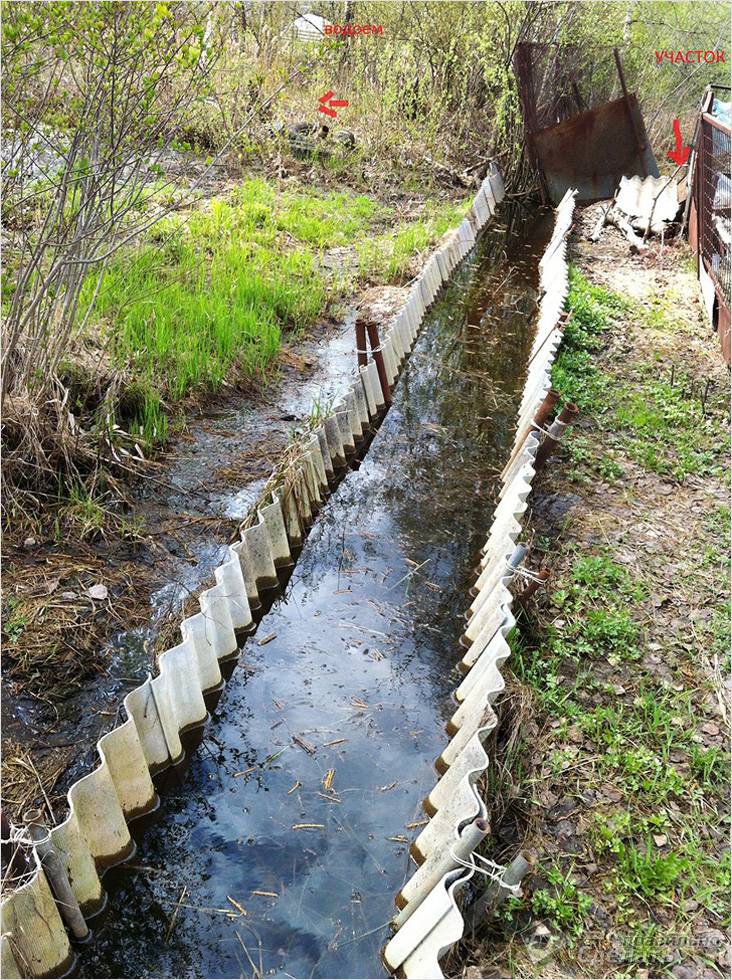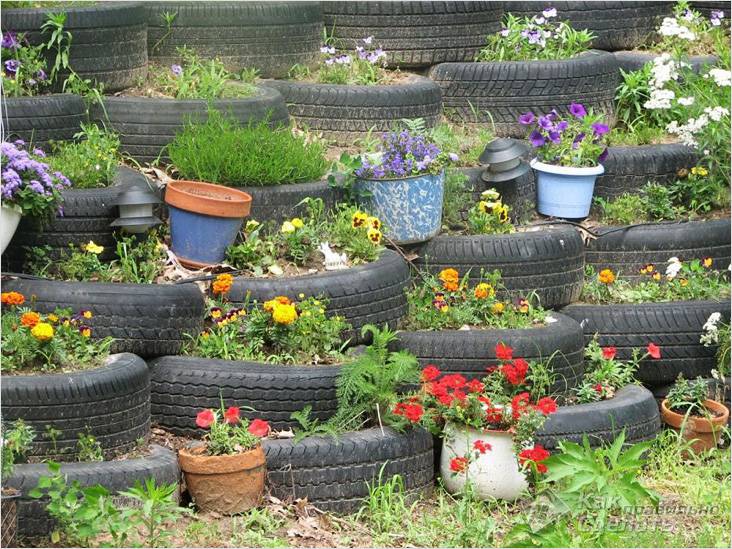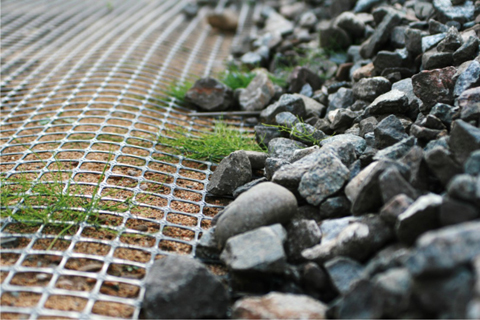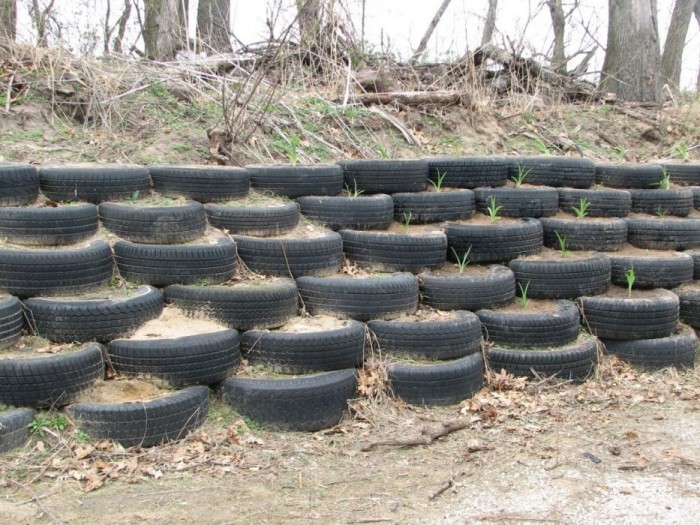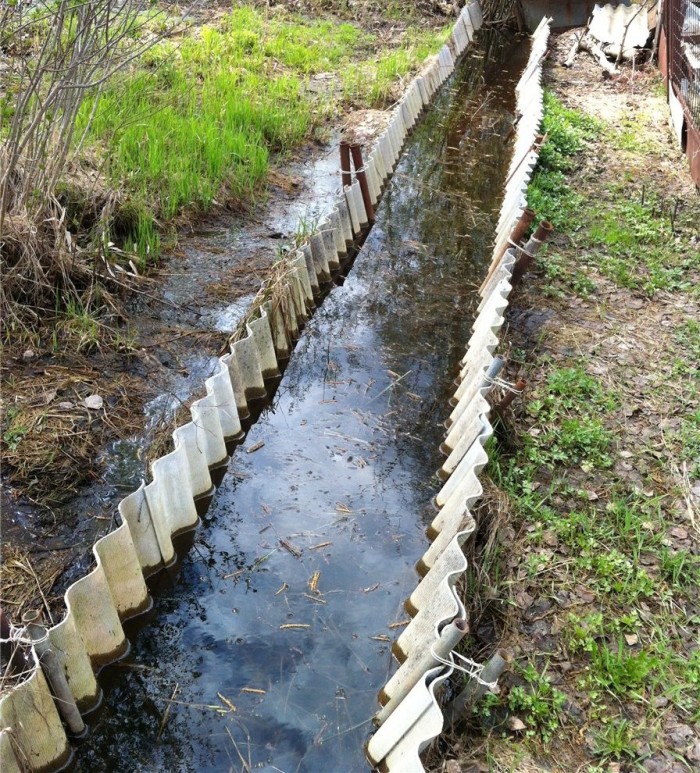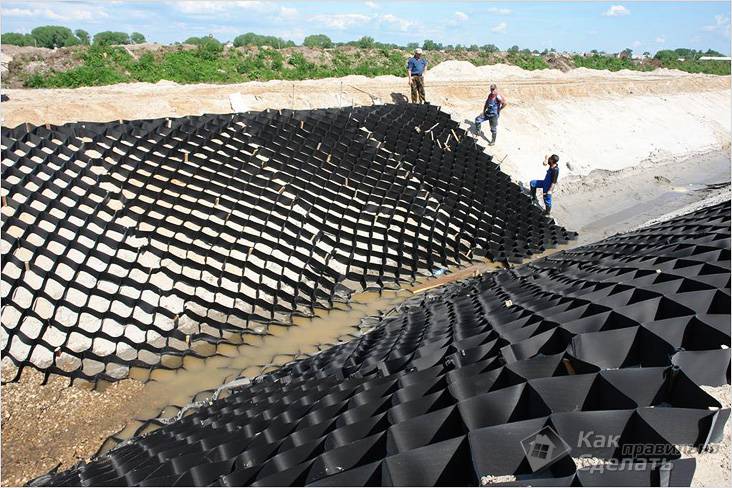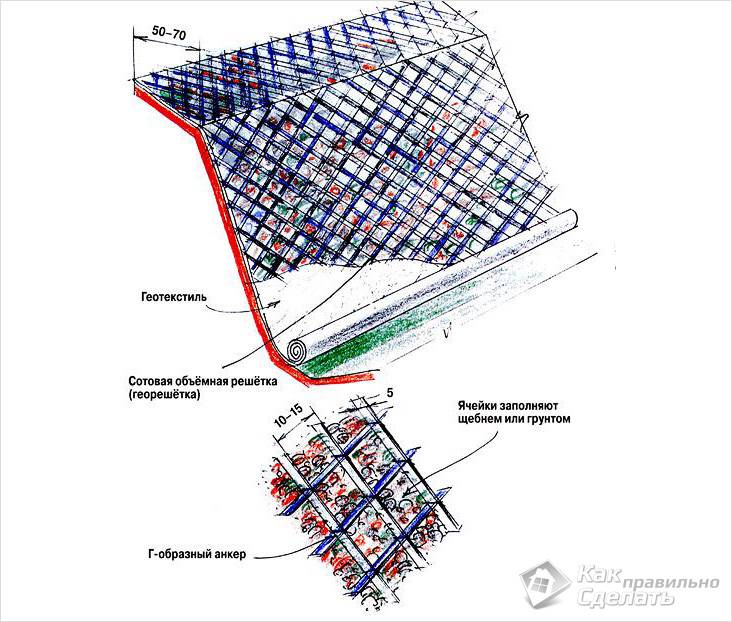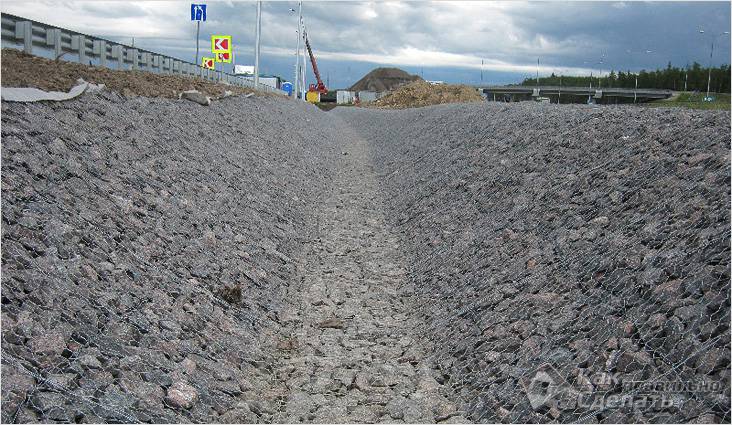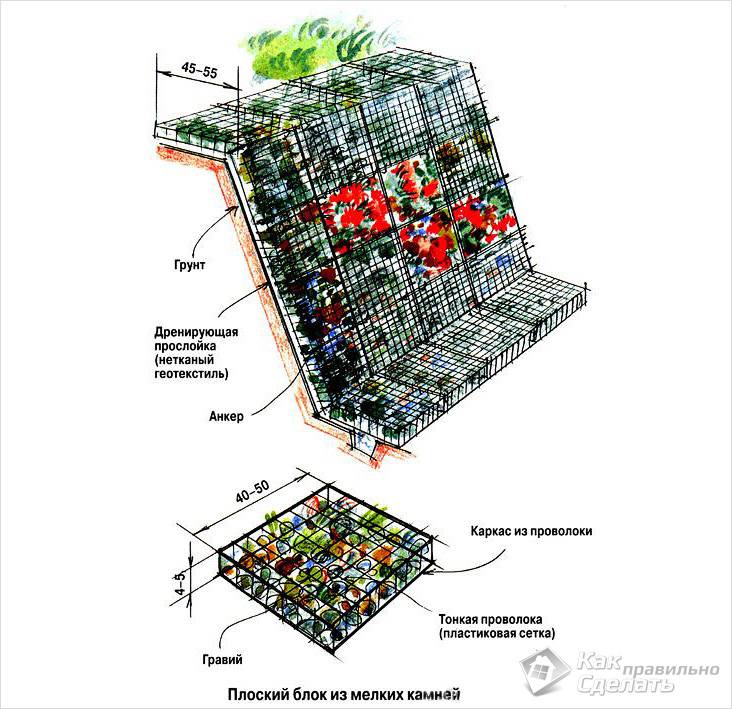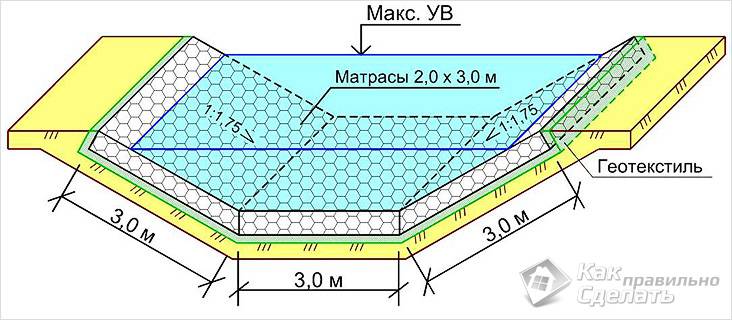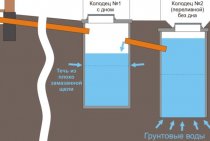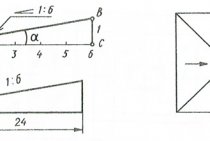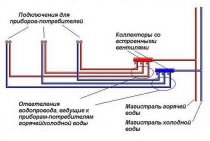Ways to strengthen the walls
Early strengthening of the walls of open drainage prevents them from shedding and allows the channel to perform its functions. The method of strengthening depends on the steepness of the slope and the size of the ditch. The larger the angle and the higher the walls, the more thorough measures are needed to fix them. On a gentle slope, in most cases, the reinforcing function of the plant root system is sufficient. Whereas it is recommended to strengthen the walls of slopes of medium steepness using:
- geomats - porous polypropylene gratings that hold the soil well and do not interfere with the growth of grass;
- geogrids - products made of polyester threads and fiberglass, made in the form of a grid with rectangular or diamond-shaped cells;
- biomats - multilayer rolled canvases filled with soil, nutrient mixture and seeds of perennial grasses.
The steepest slopes are strengthened by internal reinforcement using geogrids - durable cellular devices equipped with deep fixation fasteners; and gabions - massive structures made of galvanized mesh filled with crushed stone or rubble.
Drainage calculation
In order for the drainage system to effectively perform its inherent functions, it must be built, remembering that water always flows down the slope. That is, it is necessary to lay down a certain slope of the drainage and drainage ditch in the project.
When calculating the drainage around the house, the ring drainage scheme is most often used. The lower edge of the aquifer of the drainage ditch should be located 300 ÷ 500 mm below the base of the foundation. In this case, the slope angle in any section of the drain must be ≥ 1%, that is, ≥ 10 mm per 1 m of the ditch (pipe). Knowing the dimensions of the perimeter of the building, the depth of the foundation and the distance to the drainage well, it is not difficult to calculate and provide the necessary slope.
Strengthening the slopes on the site with terraces and plants
Hello dear friends!
Often, plots with a large slope and virgin cover are assigned to summer residents for gardens and orchards. Cultivating and digging up such an area, over time, the summer resident observes with horror the formation of meter-long gullies, the washout of the fertile layer and rickety pillars around the perimeter of his allotment.
Cereal plants, once growing on the slopes, protected and kept the soil from being washed away by natural summer precipitation and spring floods, but as soon as they were removed from the site, the land layer began to slide. Such areas require terracing and planting, that is, changing the topography of the slope surface in order to resist further soil erosion caused by the influence of water. Let's see how to do it strengthening the slopes on the site plants and terraces.
There are ditch terraces and trench terraces, which differ from each other in the level of surface slope. On large depressions, where fruit and forest trees grow, artificial terraces will well protect the fertile soil layer. For small slopes, it is preferable to make ridge terraces: when earthen ramparts are poured across the slope, the height of which is 30-50 cm. Usually preference is given to stepped terraces, as more efficient. For their device, the upper soil of 2-4 meters wide is cut off from the slope and the platforms are made according to the format of the steps. Strengthening the slopes of the terraces is carried out with the help of masonry, pieces of slate, wattle and boards.
In autumn, on such a terrace, it is necessary to make holes: dig up the soil and make holes with a diameter of 15-25 cm. This helps to prevent rapid discharge of water and improve the water regime of the slope.
A more preferable option is to plant perennials with a strong root system on sloping earthen slopes.To strengthen the relief, it is optimal to use grassy lawn compositions, cereals or meadow vegetation. Unfortunately, only carrots, horseradish, root parsley and Jerusalem artichoke can be recommended for a gardener from vegetable crops, which can partially resist the spread of soil with their root crops. To the gardener and flower grower, on the contrary, the slope of the relief of their site does not threaten further destruction: the range of crops grown by them has powerful root branches and does not need daily watering, which slows down the process of soil erosion. Berry bushes, grapes or trees cultivated by a gardener hold the soil together not only with roots, but also with vegetative layers, root shoots, shoots and fallen, germinated seeds with seeds from berries and fruits. Ground cover and climbing roses, peonies, irises, daylilies, phloxes, creepers, junipers or stonecrops planted at the grower keep the soil on the slope no worse than artificial engineering structures and mounting grids.
If the garden is laid on slopes of more than 15 degrees, then it is advisable to plant low-growing trees, since the width of the terraces or areas is about 4-5m. Landings will be more compact and more frequent, which will increase the strengthening of the soil and the retention of precipitation. From such slopes, the sod is carefully removed and set aside, then the fertile layer is removed, folded along the edges of the site and the entire area is leveled. The outer layer must be made slightly higher than the inner one, since loose earth can settle. A layer of humus is laid on a leveled area, the edges of the site are fixed with turf.
When arranging terraces and areas, it should be remembered that the slopes of the excavation should have a slope of 65 degrees, and the slopes of the bulk - 45. Pits for planting fruit trees should be dug closer to the outer edge of the site.
I hope that the articleStrengthening the slopes on the site' will be useful to you. See you!
Strengthening the slope with retaining walls
Gabion retaining wall to strengthen the slope
The terracing of the site was very often used in past centuries, as evidenced by the ancient retaining walls, worn out by time and overgrown with moss, of various ancient sights of European countries.
Today, specialists in the landscape design of the site widely use the construction of retaining walls to strengthen the slopes. This process is very simple, does not have high material costs and particular complexity in the construction technology.
If the slope is small and it is enough to build a retaining wall up to half a meter high to strengthen it, then all that is needed is to select suitable flat stones, remove a layer of earth for them, create a drainage cushion and install stones along the slope.
But if the height of the retaining wall must exceed the mark of 50 cm, then the process of strengthening the slope will become a little more difficult. Here it will already be necessary to create a small foundation and erect a retaining wall on it from concrete blocks, gabions, natural stones, etc.
The advantage of retaining walls lies in the unusual decorative decoration of the garden plot, the durability of the structure, as well as in the simple technology of creation.
But what if the retaining walls cannot fit into the garden style, and, accordingly, into the overall composition of the garden decor? In this case, it is convenient to use a slope reinforcement with a geogrid or other types of geotextiles that are invisible under a lawn or other suitable hill decoration!
Surface version of the building features
To determine which of the surface drainage methods in the country will allow you to get rid of dirt on the site, you must:
Analyze the number of places where water accumulates after a heavy rain - it may be enough to make just a few drainage points.
Determine the direction of natural flows so as not to make a mistake with the ditching path.
Find a place to drain excess water. If there is no reservoir nearby, a gutter between plots, or a deep ditch, you will have to equip a drain receiver.
Surface channels in the area
Types of surface drainage systems
With your own hands, it is advisable to equip only surface country drainage of a point or linear type - these systems do not require the use of equipment, and you can plan the places for laying ditches yourself:
Point outlet. The system of local collection of excess moisture is the installation of receivers or the arrangement of diversion ditches directly in places where fluid accumulates: in recesses, under drainpipes, in the lowest places of the site, at points of height difference. Several rainwater collection points can solve the problem if the main area is not flooded after the rain.
Linear system. This method involves covering the entire area of \u200b\u200bthe summer cottage with a system of connected trenches for draining liquid. The linear scheme is implemented with the arrangement of a closed or open system of trenches. The advantage of this method is the uniform drainage of the soil throughout the territory.
Installation of a linear drainage system in the garden
Open system for removing moisture from the ground
The easiest and cheapest way to make drainage in a summer cottage is to equip an open system of linear surface drainage. Drainage ditches are dug at an angle to a relatively shallow depth - up to 50 - 70 cm. The width of the trenches varies: from the narrowest at the beginning of the branch, to expanding by several tens of centimeters in the direction from the beginning of the groove to the connecting line. The largest width is dug at the drain. The walls of the trenches are formed at an angle to the bottom - the angle of inclination should be up to 30 - 35 °.
To strengthen the walls use:
Remains of building materials: slate, brick, concrete slabs.
Reinforced with slate sheets from shedding walls
Textiles with perforation - agro- and geotextiles. Special material that does not rot. Plants grow through small holes, which by their root system are able to strengthen the soil on the walls and protect the groove from shedding.
Gutter protection with soft material
Concrete gutters, metal mesh, stone laid on mortar.
A groove lined with river stone: this kind of gutter is easy to clean
How to make the most economical drainage in the country? Leave the channels completely open by filling them with crushed stone, gravel or a mixed gravel-sand mixture. Such a budget solution is perfect for areas where problems with soil erosion occur infrequently.
Surface drainage groove with backfill
There are many design options for open channels: ready-made trays made of plastic, metal, concrete with decorative grilles.
closed drainage network
It is much more difficult to make indoor drainage in a summer cottage without the involvement of specialists. A closed system is a network of perforated pipes laid with the obligatory observance of technology, a slope along the entire perimeter of the site.
Diagram of a closed system
To perform the work, it is necessary to accurately plan the pipe installation sites - in case of an error, the entire branch will have to be redone. Therefore, craftsmen use laser rangefinders and special equipment to calculate, to the nearest millimeter, the required depth and slope of the pipeline.
Execution of work: selection of installation direction
Before installing the perforated pipes, the dug trenches are strengthened and a bulk bed of gravel is created. Textiles must be installed under the backfill. For different parts of the system choose pipes of different diameters.
Installation of perforated pipeline
In addition to the costs of pipes and earthworks, it is necessary to calculate the number of revision tanks. Perforated pipes will have to be washed, and in order to get to the junction, wells are installed along the highway with access to the surface.
Wells are an obligatory part of a closed system
The advantage of a closed discharge system is absolute invisibility. The pipes are dug into the ground, and after the work is completed, there are no open ditches left on the surface. Closed drainage is advisable to equip during the construction of the house. In a summer cottage, which is used only for seasonal growing of vegetables, it is enough to make a simple, economical open system.
Ways to strengthen the coast
Depending on the angle of inclination of the walls of the drainage ditch, it can be strengthened in different ways. A gently sloping bank with an angle of up to 15 degrees will strengthen the cover plants well - intertwined roots are one of the best ways to prevent soil landslides.
Vertical, with an angle of 90 degrees, they are sometimes strengthened with the help of sheet slate, secured with reinforcement rods. For 1-2 years, such a strengthening is enough, but no more. In addition, the slate does not allow water to pass from the coastal soil into the ditch; it itself collapses under its influence. That is, such strengthening is inexpedient.
In order to make a reliable and durable reinforcement, modern materials are used that pass water well.
Geogrid - a polymer mesh that is laid along the entire slope of the ditch, fixed on it with anchors, and covered with soil from above. Sufficiently large cells do not interfere with the growth of small plants, which, intertwined with the roots of the mesh, make the reinforcement even more reliable. The polymer material of the mesh does not collapse under the influence of water, it is not interesting for insects or rodents - such a material is able to perform its functions for a long time. Despite its strength, the mesh is quite flexible, which makes it easy to install.
Before laying the geogrid, the slope surface must be leveled. The mesh is laid with small gaps, fixed with anchors or U-shaped brackets every half a meter. From above fall asleep with a small layer of soil. Everything - the strengthening is done.
Geomats. This means of strengthening the slopes is also made of a polymeric material and has a multilayer fibrous structure. Before laying it, you need to level the surface of the coast, fix the edge of the geomat in the upper part, roll the roll to the bottom, cut it to the desired length and fix it with anchors. The next layer is overlapped, also fixed. After the entire coastal slope is covered with mats, a 3-5 cm layer of earth is poured on top, grass seeds are sown with a density of 40 g per 1 m 2. When the grass grows, its roots, intertwined with the mats, will create a reliable reinforcement of the banks of the ditch.
By equipping the ditch with a tray and a grate, you can make it more aesthetic and safer.
The ditch can also be converted into a closed drainage system. After laying the bottom with geotextiles, filling in crushed stone or gravel, you need to close the bulk material with the same canvas, fill it with soil from above. This is the simplest version of a closed drainage system.
If the amount of groundwater, precipitation is large, you may have to make a more serious drainage system. But if this is not done, the land plot can turn into a swamp, and the buildings on it, constantly washed away from below, will collapse.
Suitable for you - you can find out from our experienced specialists, just by calling on the phone!
Advantages of the gabion
This factory product is a product made in the form of a parallelepiped from a double-twisted metal mesh and filled with large stone or crushed stone.
- For the manufacture of gabions at the factory, a special galvanized wire is used, which also has a PVC coating. It is she who reliably protects this structure from corrosion, aggressive chemical environment and mechanical damage. Even heavy loads are not terrible. The average service life can be more than 70 years. But this affects the cost.
- Therefore, you can make a gabion on your own. To do this, you will need reinforcement bars having a diameter of 6 mm, as well as electric welding.In addition, you need to stock up on a tape measure, a marker, a grinder, a chain-link mesh, a shovel and a wheelbarrow. You will also need cobblestones.
- A design with dimensions of 80 × 40 × 80 cm is suitable for a small area. Reinforcing bars are welded together, forming a rectangular structure. The width of the cells will depend on the diameter of the selected stones.
- With the help of a shovel, it is necessary to prepare and widen the slopes of the ditch. Only then can be placed along the entire coast of the cage.
- Each cell is filled with large cobblestones and, if necessary, several rows are installed at once.
- The chain-link mesh is attached from above for better fixing. In order to avoid the need to change it often, it is better to choose a mesh that will also have a PVC coating. From above it is easy to strengthen with the help of cobblestones. In addition, it gives the whole structure a good decorative look.
Gabions can last the longest, while they fit well into the ecosystem. Manufacturers guarantee at least a hundred years of service.
improvised means
One of the easiest and most easily accessible ways to strengthen the walls of a drainage ditch is to use slate. In this case, you can use the material that was in use. The main thing is that there are no large holes and cracks in it.
The technology using slate is quite simple. Sheets (whole or cut, depending on the size of the ditch) are laid on the slopes of the ditch tightly to each other. This can be done both strictly vertically and at a slight slope. Then, on both sides of the sheets, in a checkerboard pattern, pieces of reinforcement or thin pipes are driven in.
This method has both its advantages and disadvantages. The first ones include the following:
- low financial costs, and if used materials are used, then you can do without investments at all;
- ease of installation. All work can be done by one person.
The disadvantages of this design in its fragility. The appearance of the site itself may also suffer.
Strengthening slopes with the help of old car tires looks more aesthetically pleasing. In addition, this method allows you to make a structure that will last much longer than the slate version (up to several decades).
Here you can resort to two methods, depending on the available space. One involves stacking the tires along the edges of the ditch. Soil is poured inside, but sand or gravel is better. For greater reliability, metal pipes can be driven in.
Step-by-step installation of a geogrid
Even a novice landscape designer, as the owner of a summer house can be called, can strengthen a small piece of land on his own. If a ravine or a ditch with crumbling slopes is located on the summer cottage, you can use a three-dimensional geogrid - a modern polymer tape structure.
If you fill the cells of the geogrid with vegetable soil, you will prepare a great place for planting climbing or erect plants. Lawn grass or small shrubs will grow well on this site.
Geogrid elements are welded together. The result is a lattice having large sections. Lattices are filled with heavy building material, for which crushed stone, sand, concrete are quite suitable. You can fill the grids with special nutrient soil in order to plant plants in it.
Use of a geogrid to reinforce slopes and protect them from collapse.
Slopes that consist of sand or other sedimentary rock are most often and quickly destroyed. They crumble from the action of wind and rain. If the ditch crosses the summer cottage, you can strengthen both of its slopes by creating an original stone stream, or by building an unusual type of rockery, planting coniferous plants and flower beds.
Before carrying out reinforcement, soil preparation is necessary. To do this, large plants are removed, the earth is leveled and compacted as far as possible.
Geogrid laying can be done in two existing ways:
- For geotextiles. At the same time, geotextiles are spread along the entire slope, acting as a draining layer, on top of which a grid is laid.
- Directly on the ground - direct installation of the mesh is carried out, which is laid on the prepared section of the soil.
Geogrid cells must be placed along the entire slope. The material for them is chosen according to the basic principle: a wider tape is used if the slope is steeper. Lattice segments are stretched in different directions and fixed around the perimeter with anchors or specially planed pegs.
For small slopes, especially if the area is arid, where drainage can be dispensed with, it is enough to lay one geogrid - additional insulating materials are not needed.
Each cell is filled or fixed using sand or gravel for this purpose. If you plan to plant flowers, trees, grass or bushes in this place, fill the cells with fertile and fertilized soil.
You can fill the grate with earth or sand using construction vehicles, a garden wheelbarrow or a simple bucket and shovel.
This is the easiest option for strengthening the slope at their summer cottage. With fantasy turned on and using various decoration methods, you can turn any crumbling slope into a beautiful and original flowering garden.
Video
If you do not have enough funds for the arrangement of the drainage system, then do not despair! The video material suggests a method for laying drainage from old tires, which you can repeat with your own hands without involving a specialist:
The slopes of ravines, ditches and other recesses can have a different angle of inclination, and depending on this indicator, the method of strengthening is also chosen. If the slope does not exceed 8º-10º, then such a bank does not need special strengthening. It will be sufficient to plant plants with a powerful root system there. With a larger value of the angle, it is necessary to carry out strengthening work. This procedure can be carried out without using special materials in the form of geomats or gabions. Old car tires or slate sheets will do.
Before starting to strengthen the slopes of the ditch, it is necessary to prepare the surface for this work. To do this, you need to carry out the following manipulations:
- if the ditch in need of strengthening is drainage, it will be necessary to pump out the water in it to gain access to the bottom. This can be done in several ways - bail out by hand, use a pump or install an inclined pipe;
- remove debris in the form of large stones or branches from trees;
- choose the silt accumulated at the bottom of the ditch.
After cleaning the surfaces and slopes of the ditch, they can be strengthened using old car tires. Today there are two ways to use them:
- Used car tires are installed in horizontal and vertical planes. A vertical row is buried along the slope of a ditch or ravine to the width of the tire, and a horizontal layer of wheels firmly connected to each other is installed on the bottom. All free space is filled with soil, sand or fine gravel. To increase the rigidity of the structure, you can drive a stake into the middle of each tire.
- Old tires are laid in horizontal rows in a checkerboard pattern towards the slope, shifting each next row by a distance equal to half the side of the tire. The empty space between the tires is filled with material available to users.
The ideal option would be to fill the voids with earth into which you can plant trees that have a powerful root system.
You can strengthen the shore of the ditch in the summer cottage with slate sheets with your own hands. They can have a flat or wavy surface.On the space of the drainage ditch or ravine cleared of large debris and silt, pieces of slate are laid, connecting them together with metal fasteners. Iron pipes can be installed between the slate, they will give the structure even greater strength and stability. You can not be afraid that the shore will “crawl”.
The proposed options for strengthening the bank of the ditch in the suburban area are low-cost and not very laborious. It is also possible to ennoble the slope of the drainage ditch in the country with special gabions purchased on the construction market or made independently. However, this costs some money. The choice of strengthening method always remains with the owner and his financial capabilities.
- Purpose of drainage ditches
- Ways to strengthen ditches
- How is ditch protection installed?
- Conclusion on the topic
The problem of how to strengthen a ditch in a summer cottage often arises when creating a drainage system that allows you to properly remove excess moisture from the soil. To solve this issue, both improvised means and specialized materials are used.
. Knowing the rules and the sequence of their application, you will ensure the normal functioning of this necessary element of the water system.
Gabion structures are highly durable and reliable.
Arranging drainage is quite simple. The main difficulties begin with its long-term operation: the ditch requires constant cleaning, otherwise the water will stagnate for a long time. Strengthening the walls also becomes very important, since if you ignore their care, the ditch is very quickly eroded, capturing the adjacent summer cottage areas of fertile land.
Gabions. This engineering structure is used in particularly difficult cases with a high flow rate of water in a ditch or with a large, up to vertical, angle of inclination of the drainage walls. Gabions can often be seen on the banks of mountain rivers, where they protect the banks from erosion. Gabions look like a cage made of a cellular wire mesh filled with large stones: river pebbles, crushed stone, etc.
Option 2 - anti-erosion geomats
The structure of the geomat consists of layer-by-layer connected polypropylene gratings fastened with polypropylene threads. Outwardly, it resembles a multilayer cobweb. The gaps between the threads are small, so the geomat holds the soil of the slope and prevents the spread of vegetation roots. Over time, the plants are tightly intertwined with the material and reinforce the walls of the ditch.
Polypropylene of geomats is resistant to environmental conditions (water, sunlight, temperature extremes, decay), non-toxic, non-flammable.
Laying the coating is easy and can be done even in winter. Work is performed in the following sequence:
- Trench preparation, cleaning.
- We fasten the edge of the roll with anchors to the top of the slope.
- We roll the material to the bottom of the trench and cut it off.
- The lower part of the piece of material is fixed.
- We roll out the next strip of material from top to bottom with an overlap of 15 cm from the previous one.
- A layer of earth 3-5 cm is laid out on the cover and seeds are planted. At the same time, the mesh to strengthen the slopes is further enhanced by vegetation.
Installation of geomats and geogrids
Geo- and biomats are nothing more than polymers with a waterproof structure. Polypropylene grids are superimposed on each other under the action of high temperature. This structure is more like a washcloth, but this is done so that various plants can grow through the holes.
- The first step is to prepare the slope itself. It is necessary not only to level it, but also to clean it of any debris.
- Geomats are sold in rolls, so the top edge is aligned with the top of the ditch and secured there with anchor bolts.
- The roll is rolled to the bottom, and then cut and secured with anchors.
- The next roll should overlap with a tolerance of about 15 cm.
- Then you need to cover everything with a small layer of soil and use the seeds for sowing. Usually enough 40 grams per m².
- The geogrid is also available in rolls. It has a polyester base and square cells. Installation will require a tape measure, a marker, scissors, a hammer, as well as a rake and a hand roller.
- It is with the help of a roller that the slope surfaces are well compacted and leveled.
- Each roll must be cut into a certain number of pieces, after which they should be laid tightly on the slope directly to each other. Anchor metal rods or staples are used for fastening. They are especially needed in places where there is a high probability of strong winds.
- The geogrid is also covered with a layer of soil and plants such as periwinkle, mint or bryozoan are planted. True, you can just use small gravel or pebbles.
But for a more durable strengthening, you will need the use of a geogrid.
Geogrids and gabions
More powerful structures for strengthening not only slopes, but also the bottom of the ditch are geogrids. They are made from polypropylene and polyethylene. Such products are not afraid of corrosion, they are quite durable and can serve for many decades.
After draining the ditch, all debris (large branches, stones, etc.) and large vegetation are removed from the surface. In this case, small grass can be left in place. Then the geogrid is spread. This must be done over the entire area of the channel, it is advisable to immediately cut off the excess pieces.
For a long service life of the geogrid, it must be properly and securely fixed. This is done using anchor brackets or hooks. They can be purchased with a grate or made with your own hands from reinforcing bars with a diameter of 15 mm and a length of 50 to 110 cm. The fasteners are placed in a checkerboard pattern at a distance of at least 30 cm from each other.
The next step is backfilling the geogrid. Sand can be placed at the bottom of the ditch (if it is rarely filled with water) or crushed stone (if drains constantly flow in the ditch). On slopes it is better to use soil sown with grass. So the grille will more securely stay in place.
A more expensive, but at the same time more reliable, way to strengthen the slopes of the drainage ditch is to install gabions. In addition, such designs will look more aesthetically pleasing and respectable.
Gabion is a factory product made in the form of a parallelepiped (box). The material used is double-twisted metal wire. Large stones or pebbles are placed in such "boxes".
Before installing the gabion, it is necessary to prepare the slope. Since the product is of considerable size, excess soil is removed. The gabion is placed in its place and filled with large stones or rubble. For greater reliability, a chain-link mesh can be fixed on top, it is advisable to choose it also with a polymer coating. Stones or pebbles can be placed on top of the mesh to enhance the decorative look.
If you have welding skills and the necessary equipment, then you can try to make a gabion with your own hands. For this, pieces of reinforcement are suitable. They are welded together, making a lattice. For a long service life, all parts can be coated with an anti-corrosion compound.
When strengthening the slopes of drainage ditches, do not forget about the base. Here you can use sand or gravel, depending on the frequency of filling with water. If the ditch is small and located in a conspicuous place, then the bottom lined with natural stones will look beautiful. A particularly beautiful effect will be obtained in combination with gabions.
